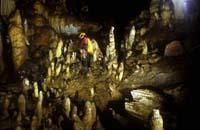Pozalagua, underground laboratory

Schoolchildren usually learn that caves are formed by dissolving limestone. But caves are more than open holes in the rock. They allow to know the history of a territory and its inhabitants. In Euskal Herria are known several treasures of this type. Praileaitz, Ekain and Santimamiñe are fundamental to know the life of men and women of the Paleolithic. Mendukilo, Pozalaga and Arrikrutz reveal the geological history of the territory in which these men and women lived.
In the underground, isolated from the outside, the caves retain ancient information. When people enter the interior, however, the existing balance is broken up until then and what nature has created for thousands of years begins to change in a short time. This is what has happened in the cave of Pozalagua.
The cave of Pozalagua was discovered by surprise in 1957. The explosion of a quarry pump exploited by the company Dolomites del Norte S.A. on Mount Ranero of Karrantza revealed. This explosion left unparalleled mineral deposits to emerge, since in the cave of Karrantza the group of eccentric stalactites of the world is preserved. Since 1990 visitors can enjoy their special curves. The space is so spectacular that it has attracted 33,000 visitors a year.
Although the cave was discovered thanks to the quarry, the tides have influenced Pozalagua a lot and many speleosubjects appear broken. But the quarry is not the only external influence that the cave has had. A few years after the visits, the vegetation began to appear and, in 2004, Alfonso Antxia, the association of speleological sciences, began to investigate the influence of visits in the cave.
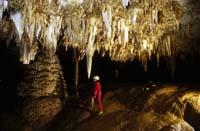
For this purpose, four climatic stations were installed in the cave. Each hour they collect twelve parameters: temperature, humidity, atmospheric pressure, carbon dioxide concentration and water and rock temperature data, among others.
Other research groups have joined the efforts of the speleological society Alfonso Antxia. The first interdisciplinary research to be carried out within a cave of Euskal Herria aims to analyze Pozalagua. Geologists, chemists, biologists, nuclear engineers and speleologists have joined forces in Pozalagua.
Diverse research
The objective of the researchers is to know the origin and evolution of the cave, to analyze the current situation and to find a way of protection for the future, by means of measures that allow combining the protection of the environment with the visitors' visits, since, at least, according to the first hypotheses, there is nothing that can disappear as a result of the visits.
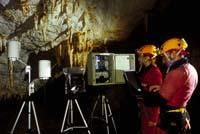
The first objective of all research groups is to differentiate the characteristics of the cave. That is to say, the working groups aim to catalogue all the stones, waters and living beings that appear in the cave and know their chemical, physical, biological and physiological composition.
The department of Mineralogy and Petrology of the University of the Basque Country is studying the creation and geological evolution of the cave. The geologist Arantxa Aranburu says: "If we know how the crystals in the cave and in the cave have formed, we will know how to care for them."
The Aramburu team has other objectives that are not limited to Pozalagua. The research hopes to contribute to completing the "gap in our geological history". In fact, "since the mountains of Euskal Herria were created - 40,000 years ago - until the archaeologists begin to know the living creatures of the caves, we do not know what has happened geologically and much of what has happened is stored in the caves". Therefore, they expect Pozalagua's research to help them advance in this field.
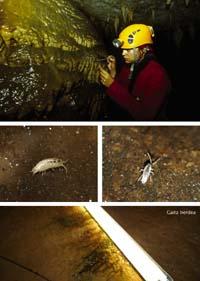
Visits to Pozalagua began almost two decades ago. In order for visitors to see the cave, an interior lighting was installed that caused a green condition. That is, the plants began to colonize the cave, finding inside moss, fungi, lichens and ferns. The department of Plant Biology and Ecology of the UPV has assumed the cataloging of the vegetation of Pozalagua.
"In addition to cataloging the vegetation, we are studying what are the best conditions for its cultivation. Plants only use the heat of light and part of the radiation. If we know what they are, we will know the necessary conditions for plant cultivation," explains Txema Becerril, a member of the Department of Plant Biology and Ecology. Thus, "by modifying these conditions, such as the wavelength light that does not reach the plants, it may be possible to continue with visits and avoid the growth of vegetation. Colder luminaires could also be used. Therefore, our work is not only to make proposals to end the cataloging and the green lacra, but also to change the conditions that make possible the proliferation of plants".
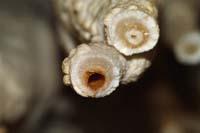
The chemicals in the research team will be of great help to help clear green disease. They have invented a species of plaster to remove the vegetation without damaging the speleotopics. The first tests of employment based on ion exchange have given excellent results. Now we are working on the ratification of these conclusions. It is also your responsibility to know the exact composition of speleotopics.
As Becerril explains, heat is one of the conditions in which living beings from outside the cave can colonize the cave, and visits also raise the temperature of the cave. For Jabier Les, member of the Asociación Espeleológica Alfonso Antxia, the systematic data collection must be 4-5 years in order to determine the impact of the visits. However, according to the data collected so far, it can be affirmed that in the months of greater influx of visits the concentration of carbon dioxide is doubled. "The result of the breathing, condensed, remains in the cave for a long time and this vapor is very corrosive."
Researchers know that speleotopics have begun to get rid of. Stalactites that are apparently well in the most affected areas get rid of their hands as soon as they touch. The eccentric stalactites precious stones of Pozalagua are the ones that have suffered the most.
The affected cannot recover, but the researchers want to find a way to prevent damage from getting worse. Multidisciplinary research is underway. No short-term results are expected, but researchers expect the knowledge collected in this underground laboratory to serve in the medium term to complete a cave management method.
